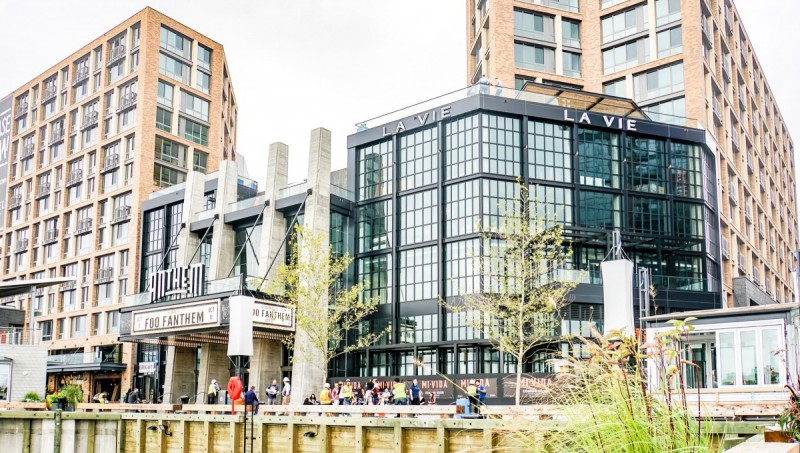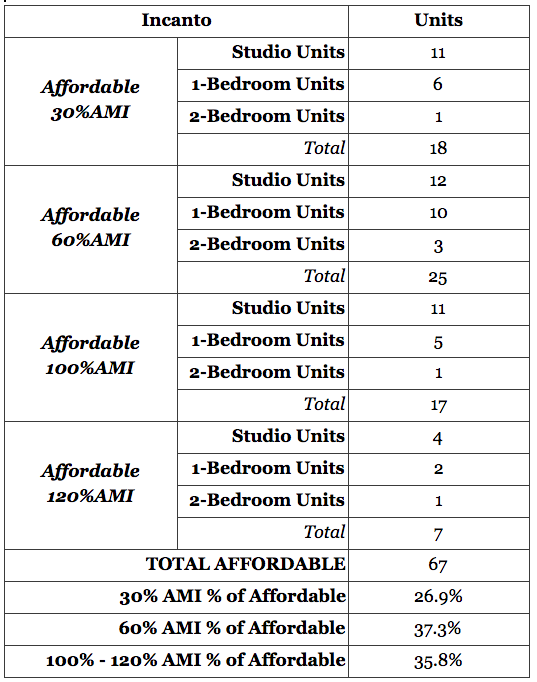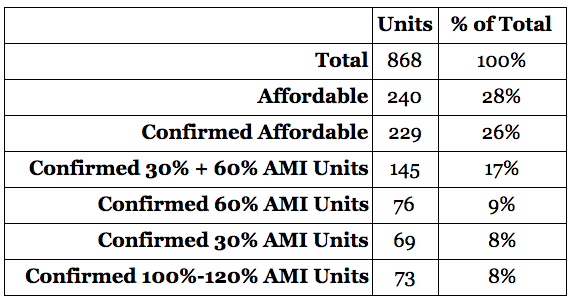The Wharf development raises the question: How affordable is ‘affordable’?

Image by Ted Eytan used with permission.
Like other new large developments in DC, The Wharf includes affordable housing, but does “affordable” really mean it’s accessible to lower-income residents? A lot these units are actually workforce housing, which goes to people making at least $76,000 (and up to $92,000) annually.
The Wharf lists 211 affordable units that are available now, which is 23 percent of the total. About 16 percent of the new apartments are affordable to low-income renters.
Of those low-income renters, only 76 of the completed 898 units are available for applicants below 60 percent of area median income (AMI), which is $65,160 for a one-person household. Just 69 are reserved for renters below 30 percent AMI, which is $32,600.
What does “workforce housing” mean?
Workforce housing means different things to different people, but an approximate definition is housing for “those who can’t afford market-rate, but aren’t considered low-income.” However, most workforce units in DC are actually renting at market-rate prices. Generally, people spend about a third of their income on rent. In DC, 30 percent of 100 percent of DC's AMI yields a studio rent of $1,925; The Channel offers studios from $1,820. Calling workforce housing affordable can be a misleading but totally legal strategy.
Image by Joe Flood licensed under Creative Commons.
Unlike low-income housing, builders of workforce units don’t benefit from tax credits. With less than market-rate rent and none of the financial incentives, workforce housing is the “hardest kind of housing to finance.” Income limits in this category run as low as 60 percent AMI to as high as 160 percent, depending on the area.
At The Wharf, workforce housing means income from 100 percent to 120 percent of AMI, or about $76,000 to $91,000 for a one-person household. The other categories of affordable units at The Wharf are below 60 percent AMI — $65,000 — and below 30 percent — $32,000. Affordable units receive reduced rents commensurate with the income category.
Workforce housing is very different from low-income housing
One of the problems with workforce housing is that the households in those income brackets have entirely different circumstances from those in low-income housing. 100 percent AMI in DC is not a king’s ransom, but folks in that position have significantly more flexibility in DC’s housing market.
More housing is needed in DC for families of all types, but it’s not clear The Wharf’s housing was constructed to help those who struggle the most. The project seems to have mostly delivered what it promised, but it’s worth remembering that the team reduced their initial affordable housing commitment, which initially reserved 15 percent of units for those making 30 percent AMI and 15 percent for those making 60 percent AMI.
Image by Ted Eytan licensed under Creative Commons._800_453_90.jpg)
Flat fees present another financial barrier to low-income residents. While low-income renters benefit from reduced rent, they pay the same additional fees charged to workforce and market-rate renters. For example, applicants for a 30 percent AMI unit at The Wharf are still required to pay an amenity fee of $500.
The Wharf’s two apartment buildings — The Channel and Incanto — advertised those discounted rents on their affordable housing flyers. Interested applicants for affordable housing at The Wharf submitted applications to a June 2017 lottery, when 47 apartments were available at Incanto and 153 at the Channel.
Hoffman-Madison Waterfront said in an email that 4,000 people applied. Unfortunately, lottery results and leasing procedures were not disclosed, and without that information, it’s hard to figure out how the process worked or compare housing demand with housing supply. We don’t know family size or income of applicants, and specifics on the available units are scarce.
One-third of Wharf “affordable apartments” are workforce housing
The most recent planning documents date back 12 months from the Phase I grand opening. They contain breakdowns of units by income and layout. Unit totals by income and floor plan are extremely important to the effectiveness of affordable housing. Larger families need larger apartments, but affordable housing options rarely include three-bedroom homes. Low-income families often fail to find affordable options in the communities they already live and have a support system of neighbors and local businesses. Affordable housing — what kind and where it goes — is often mismatched with the people it’s supposed to help.
At The Channel, only 51 of the 151 affordable units go to applicants at or below 30 percent AMI. That’s less than 34 percent of the affordable total at that building. At Incanto, only 27 percent of the affordable total goes to applicants of the least income. In both apartment buildings, one-third of all the affordable units are reserved for families making at least $76,000 for a single household and more for families of greater size.
In addition to the two apartment buildings, Phase I at The Wharf included two condo buildings.
No affordable units were made available at 134-unit VIO. Zoning commission documents were not available for 525 Water, the 107-unit condo building that opened first at The Wharf, but DC’s affordable housing dashboard says 11 affordable units have been delivered there.
In total, The Wharf claims 229 affordable units between two apartment buildings, and 11 affordable condos at 525 Water. This yields a total of 240 affordable housing units from the 898 units delivered by Phase I of the Wharf.
Only 16 percent of Wharf units are low income housing
Planning documents show that only 69 of the Wharf’s 240 affordable units are set aside for families earning 30 percent AMI. Just 76 are reserved for applicants at or below 60 percent AMI. That leaves 73 units of the Phase I affordable total to be rented to households making between 100 percent and 120 percent AMI.
Ultimately, only 16 percent of the Wharf’s Phase I units are set aside for 60 and 30 percent AMI applicants. Although the affordable housing total quoted by project officials seems more impressive with the additional eight percent of workforce housing units added, it’s not quite what one expects.
Government officials and project stakeholders frequently use similar language to describe very different realities. Affordable housing and workforce housing fit into this set of flexible language, but the specifics matter. The goal of more affordable housing is a starting place. The next question — what kind of affordable housing — matters just as much.
DC officials should ensure that developments like The Wharf expand the housing choices of those who have the least. Workforce housing is affordable for the families who have alternatives, but is a non-starter for households that need homes the most.



